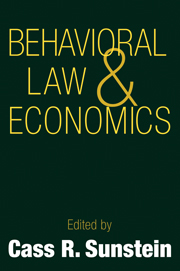Book contents
- Frontmatter
- Contents
- Contributors
- Acknowledgments
- Introduction
- Part I Overview and Prospects
- Part II Heuristics and Biases: Shortcuts, Errors, and Legal Decisions
- 2 Context-Dependence in Legal Decision Making
- 3 A Positive Psychological Theory of Judging in Hindsight
- 4 Behavioral Economics, Contract Formation, and Contract Law
- 5 Organized Illusions: A Behavioral Theory of Why Corporations Mislead Stock Market Investors (and Cause Other Social Harms)
- 6 Reluctance to Vaccinate: Omission Bias and Ambiguity
- 7 Second-Order Decisions
- Part III Valuation: Values and Dollars in the Legal System
- Part IV The Demand for Law: Why Law Is As It Is
- Index
7 - Second-Order Decisions
Published online by Cambridge University Press: 05 June 2012
- Frontmatter
- Contents
- Contributors
- Acknowledgments
- Introduction
- Part I Overview and Prospects
- Part II Heuristics and Biases: Shortcuts, Errors, and Legal Decisions
- 2 Context-Dependence in Legal Decision Making
- 3 A Positive Psychological Theory of Judging in Hindsight
- 4 Behavioral Economics, Contract Formation, and Contract Law
- 5 Organized Illusions: A Behavioral Theory of Why Corporations Mislead Stock Market Investors (and Cause Other Social Harms)
- 6 Reluctance to Vaccinate: Omission Bias and Ambiguity
- 7 Second-Order Decisions
- Part III Valuation: Values and Dollars in the Legal System
- Part IV The Demand for Law: Why Law Is As It Is
- Index
Summary
According to one picture of practical reasoning, people are decision-making animals, assessing the advantages and disadvantages of proposed courses of action and choosing in accordance with that assessment. This picture plays a familiar role in economics and decision theory; in various forms it is central to leading descriptions of reasoning in law and politics. Even in psychology, where models of bounded rationality are pervasive and where it is common to speak of “satisfying” rather than optimizing, the deviations can be understood only against the background of this picture.
As many people have noticed, this understanding of practical reasoning is quite inadequate. An important problem is that it ignores the existence of simplifying strategies that people adopt well before on-the-spot decisions must be made. A central point here is that people seek to overcome their own shortcomings – calculative, moral, or otherwise – by making some metachoice before the moment of ultimate decision. Both rational and boundedly rational people attempt to minimize the burdens of choice and the likelihood of error.
By second-order decisions we refer to decisions about the appropriate strategy for reducing the problems associated with making a first-order decision. Second-order decisions thus involve the strategies that people use in order to avoid getting into an ordinary decision-making situation in the first instance. In law, for example, some judges favor a second-order decision in favor of rules, on the ground that rules promote predictability and minimize the burdens of subsequent decisions.
- Type
- Chapter
- Information
- Behavioral Law and Economics , pp. 187 - 208Publisher: Cambridge University PressPrint publication year: 2000
- 6
- Cited by



